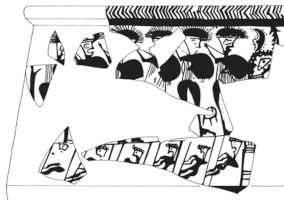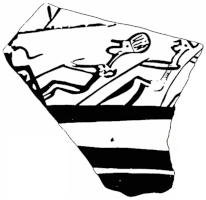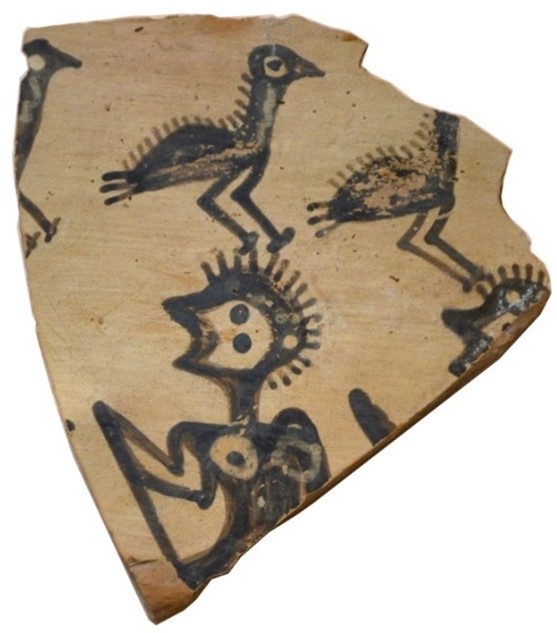Two rowers with "hedgehog" helmets facing to the left, with their torsos upright and both hands on the oar. The first one is visible down to his torso, the second one has only the top of his head and the top of his oar preserved. The chest of the first warriors is drawn with reserved circles with a dot, which could be a way to indicate a cuirass with embossed nipples, potentially of central European influence (Molloy 2013: 289). There are three birds facing in the opposite direction over the rower's heads, effectively touching the crests of their helmets. No elements of the ship itself are preserved.
Two rowers
A108
LH IIIC
Voundeni, Amygdalia, western Achaia
n/a
Sherd from a krater. Clay shows local production. Details rendered with added white paint.
Patra Archaeological Museum
Kolonas 2009; Yasur-Landau 2012: 30; **(site generally)**: Berg 2018; Moschos 2009
The settlement enjoyed access to the sea through a harbour occupying the estuary formed by the deposits of the river Leilichos (present day Ayia swamp), situated on the coast north of the Mycenaean settlement. A naturally fortified position, the site on Bortzi hill provided good visibility towards both the sea and land passages, as well as fertile soils and soft rock which eased the carving of the tombs. Voundeni's 1.8 ha cemetery is southeast of the settlement, at the localities of Agrapidia and Amygdalia. 75 tombs have been excavated by Kolonas at Amygdalia, dating between LH IIB and LH IIIC, with some continuing to be used during the SM period. Unfortunately, these are still unpublished. Voudeni is described by Berg as one of the "super hubs" in the Patras region regarding long-distance Italo-Aegean (and some Balkan) connections during LH IIIC, as it has yielded along with Kallithea the largest number of Urnfield objects (weapons, tools, ornaments) both in terms of pure numbers and the diversity of types (notably leaf-shaped spearheads, Naue II swords, Peschiera daggers, violin fibulae, bow fibulae, long pins, spiral rings)(Berg 2018: 211, 442, Tables. XXXV, XXXVI, XL). These connections were initiated prior to the transition, yet the network continued and even expanded after 1200. Kolonas notes that imports from the Argolid and Crete are also in evidence, indicating that maritime routes were quickly re-organized.
Berg, van den, K.A.M. 2018. “Keeping in touch in a changing world: Network dynamics and the connections between the Aegean and Italy during the Bronze Age-Iron Age Transition (ca. 1250-1000 BC).” PhD thesis, Vrije Universiteit, Amsterdam.
Kolonas, L. 2009. Voudeni. An Important Site of Mycenaean Achaia. Athens: Ministry of Culture, Finance Manafement Fund for Archaeological Projects.
Moschos, I. 2009. “Evidence of Social Re-Organization and Reconstruction in Late Helladic IIIC Achaea and Modes of Contacts and Exchange Via the Ionian and Adriatic Sea,” in E. Borgna and P. C. Guida (eds.) Dall’Egeo all’Adriatico: Organizzazioni sociali, modi di scambio, e interazione in età post-palaziale (XII – XI sec. a. C.). From the Aegean to the Adriatic: Social Organizations, Modes of Exchange and Interaction in Postpalatial Times (12th – 11th BC.). Seminario internazionale, 1-2 Dicembre 2006/Intern
Yasur-Landau A. 2012. “The ‘feathered Helmets’ of the Sea Peoples: Joining the Iconographic and Archaeological Evidence,” TALANTA 44: 27-40.






